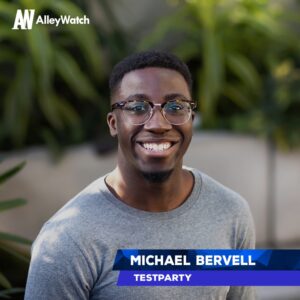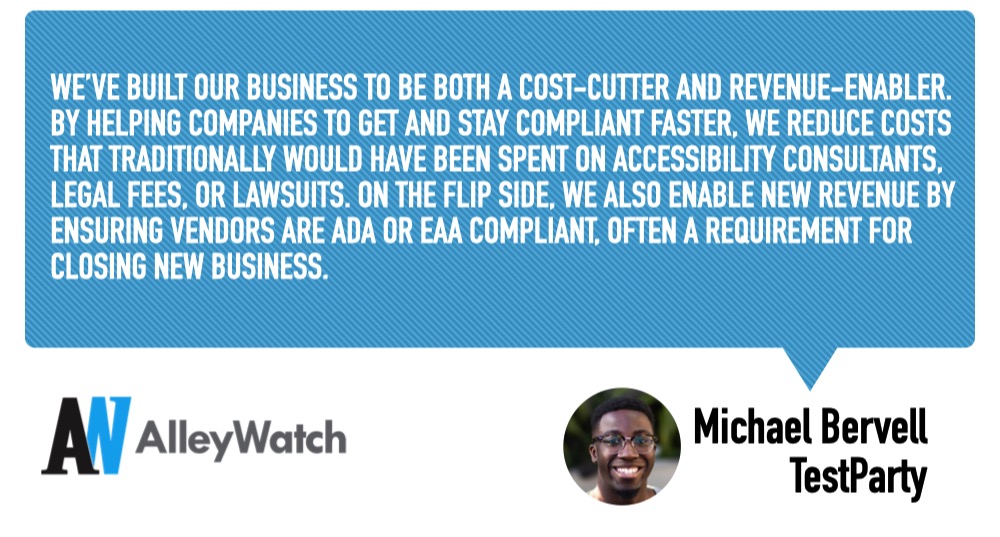The American Disabilities Act (ADA), passed in the early 1990s before the meteoric growth of the consumer internet, did not include technical standards for web accessibility. However, the Web Content Accessibility Guidelines (WCAG) 2.1, last updated in 2023, provide a widely accepted framework to ensure websites are inclusive and free of barriers that prevent or inhibit access for individuals with disabilities. Despite this, over 96% of the homepages of the million most trafficked websites are not compliant with these standards. TestParty aims to change this with its AI-powered platform that automates accessibility testing, training, remediation, and monitoring. The platform enables developers to create web experiences that are accessible to individuals with physical and situational disabilities, ensuring equal access to functionality and information. Previously, ensuring a website met accessibility standards required manual testing, which is expensive and time-consuming, and often outsourced to external consultants. Now, with TestParty, engineering teams can build with ADA compliance in mind from the onset.
AlleyWatch caught up with TestParty Founder and CEO Michael Bervell to learn more about the business, the company’s strategic plans, recent round of funding, and much, much more…
Who were your investors and how much did you raise?
We raised a Seed round of $4M. The financing was co-led by Harlem Capital and the Urban Innovation Fund with participation from K Ventures, Soma Capital, the MBA Fund, Gaingels, Bain Capital Ventures (Scout Fund), and the National Science Foundation’s (NSF) Small Business Innovation Research Program (SBIR).
Tell us about the product or service that TestParty offers.
TestParty is creating an innovative AI platform that automates accessibility testing, remediation, training, and monitoring. We help software developers make digital assets more usable for people with disabilities by augmenting their existing skills with artificial intelligence. We’re like “spellcheck for accessible code.”
What inspired the start of TestParty?
 Jason Tan (my cofounder) identified the opportunity after experiencing first-hand frustration with the existing suite of options to make digital products accessible. He was at Twitch when they were sued for digital accessibility violations. In researching solutions, we discovered that accessibility lawsuits were an industry norm, with more than $370 million paid in damages and settlements over the last five years. The Internet has grown so fast that society has blown past the guardrails that would help differently abled people enjoy the benefits of successfully using popular digital tools.
Jason Tan (my cofounder) identified the opportunity after experiencing first-hand frustration with the existing suite of options to make digital products accessible. He was at Twitch when they were sued for digital accessibility violations. In researching solutions, we discovered that accessibility lawsuits were an industry norm, with more than $370 million paid in damages and settlements over the last five years. The Internet has grown so fast that society has blown past the guardrails that would help differently abled people enjoy the benefits of successfully using popular digital tools.
Instead of hiring specialized consultants who charge upwards of $300 an hour, we believe that any engineer can be upskilled through AI to write accessible code.
How is TestParty different?
Up until now, there have been two ways of getting a company’s digital assets compliant: overlays and accessibility software consultancies. Unlike overlays, TestParty focuses on correcting underlying accessibility errors within the source code and using a human-in-the-loop to approve code changes. This is significantly cheaper and faster than manual testing and manual remediation from software consultancies. We are a pioneering entrant, creating a third space of “automated digital accessibility testing and remediation.”
What market does TestParty target and how big is it?
The market for Compliance Management Software tops well over $30B. We believe that finding a way to automate tedious coding tasks will not only reduce the chance of lawsuits and the number of inaccessible websites, but also expand every company’s market potential. For example, differently-abled individuals and their families have a spending power of $13T annually. With 17% of the world’s population (over a billion people) living with a disability, it’s a shock that 96% of the world’s top million website homepages are not compliant with the Web Content Accessibility Guidelines. Our mission is to change this.
What’s your business model?
We’re a SaaS business. Companies can subscribe to use our software to upskill their software engineers into accessibility engineers.
How are you preparing for a potential economic slowdown?
We’ve built our business to be both a cost-cutter and revenue-enabler. By helping companies to get and stay compliant faster, we reduce costs that traditionally would have been spent on accessibility consultants, legal fees, or lawsuits. On the flip side, we also enable new revenue by ensuring vendors are ADA or EAA-compliant, often a requirement for closing new business.

What was the funding process like?
The fundraise started with a preemptive term sheet and ended with an over-subscribed round. Over the course of 2 months, Jason and I talked to nearly 100 investors. When we chatted with Harlem Capital, it was a natural fit. As a former intern at Harlem Capital, I stayed in contact with the team and participated in alumni events. It’s the first time that the firm has invested in a company founded by an alumnus, but it’s a vote of confidence in our business model and team. Urban Innovation Fund saw the same signals and our customer’s enthusiasm to co-lead the round.
What are the biggest challenges that you faced while raising capital?
Many did not believe in the accessibility compliance market as a venture-scale outcome. We believe whole-hearted that WCAG-compliance will be as important for the world as SOC2-compliance or GDPR, especially given the tailwinds of the European Accessibility Act being passed in June 2025. However, most funds do not have a thesis around this area. We were both pitching and educating throughout our fundraising journey.
What factors about your business led your investors to write the check?
For a seed-stage company, we had a significant amount of pipeline with our target customer segment. Within 6 months of having the idea for the business, we surpassed $50K in closed ARR which told us that we were onto something. Investors were attracted to this, in addition to our customer’s enthusiasm.
What are the milestones you plan to achieve in the next six months?
Primarily two. First, hiring. We’re looking to expand our team of 3 full-time employees to ~10 full-time employees. Primarily in the engineering side of the business. Second, learning with deep empathy from customers who in turn will inform our product vision. We have three immediate hypotheses for how to grow but are looking for customers to lead us in the right direction through their needs and feedback.

What advice can you offer companies in New York that do not have a fresh injection of capital in the bank?
Entrepreneurship is a game of persistence.
Where do you see the company going now over the near term?
Our mission is to empower developers to build a more accessible Internet. We also see an opportunity to expand beyond accessibility to automatically rewrite compliance code in the backend (SOC2, PII, HIPAA, etc.), correct failing production code, and optimize existing codebases for speed or performance. No more audits or audit reports for code: just automated suggestions and code fixes within engineering codebases. Accessibility is just the beginning.
What’s your favorite summer destination in and around the city?
Storm King Art Center: it’s one of the greatest reprises from the city to stop and revel in awe of sculpture. It’s just a short drive from Manhattan but feels like you’re transported into a whole new world of curiosity, art, and philosophy. I’d recommend a day trip!





